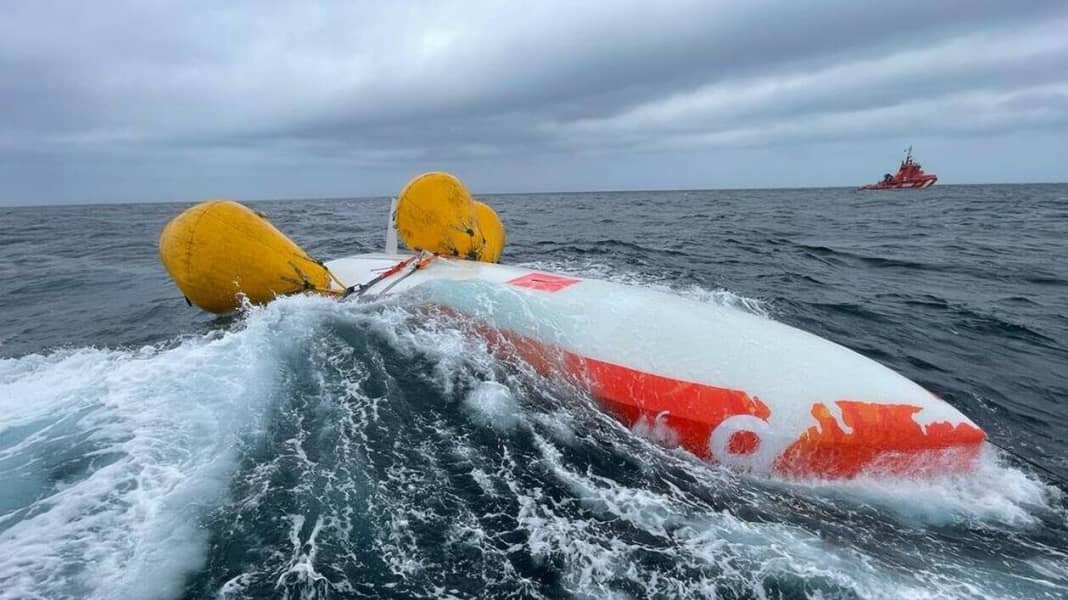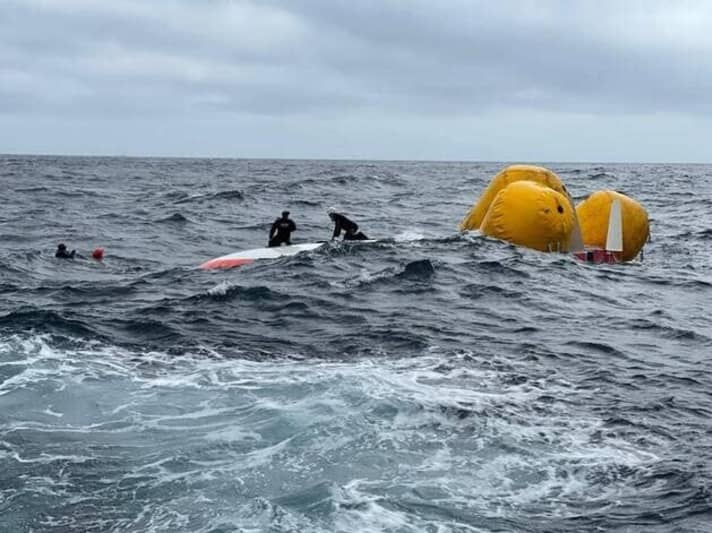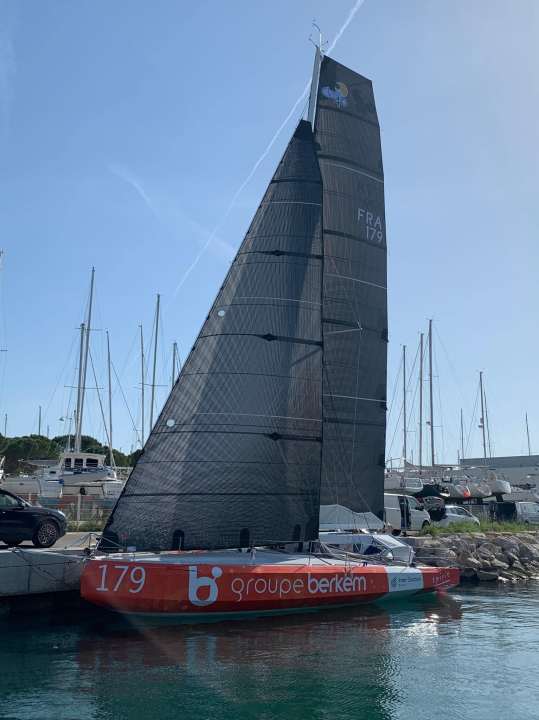
On Monday, French single-handed sailor Laurent Camprubi, who was on the qualifying course for the Route du Rhum 2022, triggered his emergency transmitter shortly after 8 pm. His new Class 40 had lost its keel 14 nautical miles off the Sisargas Islands in north-west Spain without prior notice and had subsequently capsized.
This was followed by a large-scale rescue operation coordinated by the Salvamento Maritimo, the Spanish state sea rescue organisation. The rescue coordination centre immediately dispatched a helicopter, which located the ship just three minutes after the distress call. Several ships, divers and other helicopters were also deployed.
The Class 40 was drifting without a keel in rough seas and strong winds. Five rescue divers first checked whether the skipper was still on board. Apparently there were signs of life. However, before he could actually be rescued, the racing yacht first had to be prevented from sinking with the help of three buoys. Only then were the rescuers able to examine the capsized boat more closely and discovered that the skipper was still alive inside.
At this point, you will find external content that complements the article. You can display and hide it with a click.
Laurent Camprubi was on a qualifying race to compete in the Route du Rhum in November. Similar to a Farr X2 that recently lost its keel off Australia The skipper had only launched his boat, a Cape 40 V2 designed by Étienne Bertrand, a few months earlier.
It is still unclear how the keel could have been lost in a wave of around two metres and 25 knots of wind.
"The accident happened within 15 seconds. I was sailing and it happened suddenly, just like that," the sailor himself told the Spanish news agency EFE. He immediately sent out a distress signal and heard the Spanish sea rescue helicopter for the first time shortly before nightfall.

Meanwhile, the 62-year-old solo sailor was put to a tough test, as the rescue proved to be extremely challenging due to the prevailing conditions. Meanwhile, the Frenchman in his survival suit was crouched half underwater inside his ship. The suit and about 30 centimetres of air kept him alive.
The swell initially made it impossible for the divers to get to him. It was not until midday on Tuesday, 16 hours later, that they were able to reach the boat from below and actually recover Camprubi alive.
He was immediately flown ashore and hospitalised with mild hypothermia. While he is well again, the boat was initially towed to the harbour of Oza in A Coruña, still upside down.

The shipyard of this Class 40, Cape Racing Yachts in Cape Town, has so far only stated on their Facebook page that they are "currently working with the team to determine what happened".
The design office Owen Clarke Design, which had two of its fifth-generation Class 40s built by Cape Racing Yachts in recent years, also intervened. In its statement, it clearly distanced itself from the incident and emphasised that the Class 40 involved in the accident was not its design.
The last two Class 40s built by Cape Racing Yachts were designed by Étienne Bertrand. In its statement to YACHT, Owen Clarke Design also warns against making hasty assumptions about the possible causes and culprits: "Many will jump to the conclusion that the designer or builder is responsible for the failure, but that is far too simplistic." The British designers are also in favour of learning from the incident in order to maintain confidence in the safety of the class.
Here is the text of the announcement:
"In recent years Cape Racing Yachts built two of our fifth-generation design Class 40s; #149 and #157. The latter was self-sponsored/named for some of its early races as Cape Racing Yachts. Because of this and our significant web/internet visibility with those boats and the Cape Racing Yachts brand we feel we need to avoid confusion by informing all parties that the two most recent boats they built, # 168 and #179 were designed by Etienne Bertrand.
We also caution all parties not to jump to conclusions regarding incidents like this. The reasons for such failures are rarely as simple as the outsider might think. Many will jump to the conclusion that the failure is the responsibility of the designer or the builder, but that is way too simplistic. The failure may not even be the keel itself and if it were there could be metallurgical, operational, installation and corrosion issues; any of which or a multiple of these that have initiated the problem.
OC send our best wishes to #179s crew and owner for the recovery of their yacht and hope to see them at the start of the Route du Rhum. Our thoughts also go out to Andrew Thomson of Cape Racing Yachts and Etienne Bertrand at what we know will be a particularly worrying and stressful time for them.
Clearly there may be lessons to be learnt by all, including the Class with regard to the management of the design and construction of appendages in the future. The Class has an excellent safety record, one that needs to be maintained. Practically we must not and certainly cannot be seen to be resting on our laurels. This was a serious incident. Had it happened at night, in the first week of the Route du Rhum, the result could have been very different."

